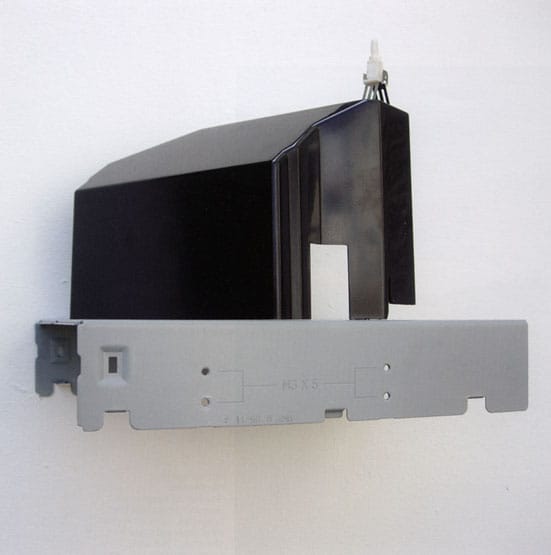20th October 2007 — 11th November 2007
In
the introduction to the catalogue for this exhibition, curator and
artist Gaia Persico describes Isobar as 'a temporary and variable
line'. This meteorological definition articulates very neatly the
ephemerality and fluidity of contemporary drawing practice which is the
focus of the current show at Fieldgate Gallery. The notion of drawing
as a process involving the making of marks on a two-dimensional surface
has been exploded over recent decades, and the range of media that
artists use are now more diverse than they have ever been before. Of
the forty works on show here, for example, only a handful incorporate
graphite. In its place, fruit, computer components, dust and 8mm film.
Natural and organic processes feature prominently among the first group
of pieces on display. Finlay Taylor's snail-eaten books have instant
appeal, both for the relic-like quality of the objects presented and
the humour in the idea of employing armies of small animals to assist
in the process of making. For one piece, East Dulwich Library, Taylor
left a dictionary in the earth for 6 months to be worked on by slugs,
snails, worms and woodlice. The resulting object appears as a kind of
mummified rarity, the fabric of the hardback cover like muslin wrapped
around skin. This is surely a remnant of an extinct civilisation.
Perhaps a comment on the fragile status of the hard copy in our age of
digitilisation. Alongside Taylor is one of Tonico Lemos Auad's
trademark banana bunches. The British-born Brazilian uses pins to score
the surface of the skin which, after several days, turns black.
Skeleton forms appear. Eventually the black turns to white as the fruit
deteriorates further creating a negative of the original image.
In contrast to these artist's fascination with nature Jools Johnson
addresses man-made technology. His constructions using redundant
computer parts stand as monuments to his own mixed feelings about the
act of staring at pixelated screens for hours on end. With an
incredible economy he creates sublime forms with perhaps just three or
four components. There is a touch of George Lucas in the aesthetic of
these pieces though this is apparently not conscious on Johnson's part.
These works are fixed to the wall using screws from the same machines
he dismantles, which creates a pleasing circularity of process. Another
entirely separate piece of work by the same artist appears from a
distance as a strip of green Astroturf. It seems that the 'grass' is
slightly too long and it is not until we are much closer that it
becomes apparent that the carpet is made from wooden golf tees; 12,000
of them in two shades of green. There is something almost religiously
ritualistic about the iterative manner in which this piece has come to
be.
Sarah Woodfine exhibits what might be considered the most traditional
kind of drawing, employing pencil on paper, though it is by no means
conventional. Her technique is painstaking and results in extremely
seductive surfaces. In one piece Junior, a werewolf stands against a
night sky - the blacks as smooth and dark as possible. On the reverse,
an orchid. The paper is mounted on card which stands inside a bell jar.
In another, Alfred's Story II, a car lies submerged in a lake. We can
only make a barely informed guess at the content of the narrative here
but the visual strength of this piece is sufficient to hold our
attention.
There is so much good work in this exhibition that it seems unfair
covering only a few of the artists here. It is clear that a great deal
of energy has gone into the curation and every artist makes a
significant contribution to the over-arching agenda. Michael Robbs's
animation Mistrust of the Image as Representation is a brilliant
comment on the discrepancy between truth and reality in the way that we
see. In attempting to draw a straight line using Photoshop the
magnified results of the various tools highlight their inadequacies to
render what is desired of them. But it is probably Claude Heath's
computer-generated animation Universe which embodies the spirit of the
show more than any other piece. Like a global weather system, particles
of what could be pixelated dust swarm around a voided sphere. The
'cloud' appears to be swelling and expanding outwards. Drawing as a
discipline has morphed and expanded through its incorporation of so
many different methodologies and Heath's Universe somehow seems to
express something of this transformation.
AJL
Fieldgate Gallery
14 Fieldgate Street
London E1 1ES
http://www.fieldgategallery.com/
Open
Friday-Sunday, 1pm-6pm
